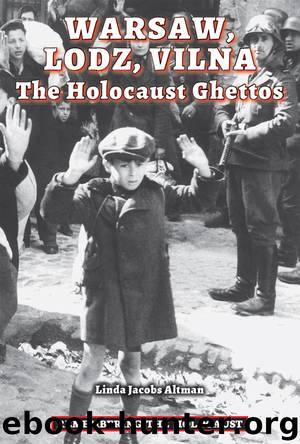Warsaw, Lodz, Vilna by Linda Jacobs Altman

Author:Linda Jacobs Altman [Altman, Linda Jacobs]
Language: eng
Format: epub
ISBN: 9780766062092
Publisher: Enslow Publishers, Inc.
Published: 2015-03-19T16:00:00+00:00
Chapter 5
LIVING IN THE CRACKS
While the Jewish leadership tried to satisfy Nazi demands in order to save the ghettos, ordinary Jews were busy simply trying to survive from one day to the next. To preserve their last shred of freedom, Jews learned how to hide from Jewish police and Nazi soldiers, how to pose as Gentiles on the Aryan side, how to steal and how to smuggle. Some even became outlaws and gangsters.
The Smugglers
Smuggling was not only common in the ghettos, but necessary for survival. Ghetto food rations were calculated for slow starvation. Knowing the need for adequate food, most Jewish councils tolerated smuggling, or even encouraged it. According to estimates in the Warsaw ghetto, legal imports accounted for two million zlotys; illegal ones, for as much as eighty million zlotys.1
Emmanuel Ringelblum tells of two men known throughout the Warsaw ghetto as Kohn and Heller. Before the war, they operated a successful import-export business. During the war, they secretly turned to large-scale smuggling. Kohn and Heller brought in huge quantities of food and medicine, maintained a retail food store within the ghetto, and operated horse-drawn streetcars that provided the ghetto’s only form of public transportation. In their spare time, they blackmailed ghetto residents and acted as informers for the Germans.
Another Jewish criminal, Abraham Gancwajch, managed to get appointed director of a special “economic police force” in the Warsaw ghetto. Under direct orders from the Gestapo, Gancwajch and his henchmen set up an office at 13 Leszno Street. Because of this address, the organization quickly became known as “the Thirteen.” Its job was to mount a “war against speculation and excessive prices”2; in other words, to crack down on smuggling and black market activities.
The Thirteen soon had a hand in every illegal enterprise within the ghetto. They ran a “protection” racket, taking huge payoffs from people who were involved in the selling, buying, or transporting of illegal goods. At one time, Gancwajch had become so powerful that he challenged Adam Czerniakow and the Judenrat for control of the ghetto government. His “reign” ended abruptly in 1942, when the Gestapo swept through the ghetto, killing every member of the Thirteen they could find. Gancwajch himself slipped through their net. He was never seen again.
Most smugglers were not highly organized professionals, but ordinary people who transported small quantities of food and other illegal goods. They sold or traded any valuables their families had saved, dealing mostly with Polish civilians. Many were young children, whose small size enabled them to slip through tiny openings in the wall or barricade. Boys and girls as young as six or seven became “artful dodgers,” eluding the Gestapo, the Thirteen, and the Jewish police to bring food to their families.
“All of them bear humps on their backs . . .,” Chaim Kaplan observed. “Anyone who didn’t know their occupation would think them deformed.”3 The humps were actually storage containers, filled with potatoes, onions, and any other foods the youngsters had managed to obtain.
Download
This site does not store any files on its server. We only index and link to content provided by other sites. Please contact the content providers to delete copyright contents if any and email us, we'll remove relevant links or contents immediately.
